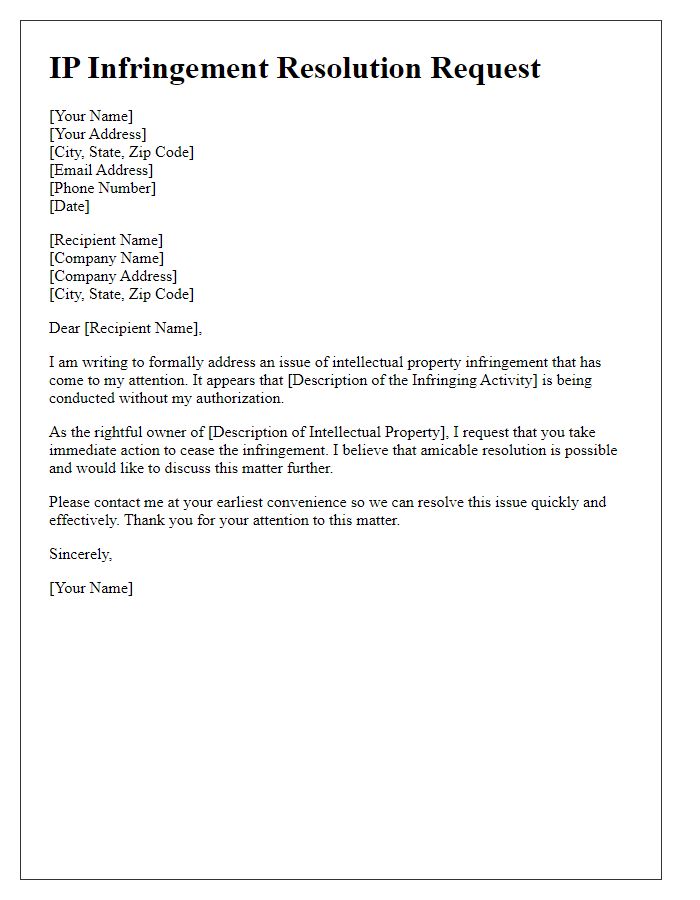Welcome to our comprehensive guide on crafting the perfect letter for an intellectual property infringement claim! Navigating the complexities of intellectual property rights can be daunting, but with the right tools and knowledge, you can effectively communicate your position. This article will walk you through essential tips and provide a detailed template to help ensure your claim is taken seriously. So, let's dive in and empower you to protect your creative effortsâkeep reading to learn more!

Claimant's information and contact details
Intellectual property infringement claims often involve significant details. The claimant's information should include a full name (e.g., John Smith), a business name (if applicable, e.g., Smith Designs LLC), and a specific contact address (e.g., 123 Main Street, Suite 100, Springfield, IL 62701). Additionally, the claimant must provide a valid email address (e.g., johnsmith@mail.com) and a phone number (e.g., (555) 123-4567) for direct communication. It's crucial to ensure that all contact details are current, enabling timely response from the accused party or legal representatives during the resolution process. Accurate and comprehensive claimant information establishes credibility in the infringement claim, making it easier for authorities or legal entities to engage with the parties involved.
Infringement description and evidence
Intellectual property infringement occurs when a third party uses, reproduces, or distributes protected materials without authorization from the rights holder. For instance, in 2023, a prominent software company discovered that its proprietary code, protected under U.S. Copyright Law (Title 17 of the U.S. Code), had been replicated in a competitor's product. Evidence gathered included screenshots of the copied code and server logs showing unauthorized access to the original software. Registered trademarks, such as the unique logo, were also misappropriated by the competing entity during a marketing campaign, leading to consumer confusion and brand dilution. Legal action often involves sending a cease-and-desist letter to the infringing party, requesting immediate cessation of the unauthorized use and compensatory damages for the losses incurred.
Legal basis and rights asserted
Intellectual property infringement claims are initiated based on the violation of recognized rights, such as copyright, trademark, or patent law. Copyright protects original works, ensuring creators retain exclusive rights to their expressions; violations can include unauthorized reproduction or distribution. Trademarks safeguard brand identifiers, preventing misleading similarities that cause consumer confusion; infringement occurs through the unauthorized use of a registered mark. Patent laws grant inventors exclusive rights to their inventions, typically for 20 years; patent infringement arises when another party makes, uses, or sells the patented invention without permission. Claimants assert their rights by detailing specific infringements, including descriptive examples of the unauthorized use, the relevant legal statutes involved, and the potential damages incurred. Additionally, documentation of original ownership or registration may be required to strengthen the claim.
Demands and corrective actions required
An intellectual property infringement claim arises when an individual or entity utilizes, reproduces, or distributes someone else's protected work without authorization. In this context, the infringing party must cease all unauthorized activities related to the protected material, such as copyrighted works, trademarks, or patents. Correction measures may include removing infringing content from public platforms, providing an account of revenue generated through the infringement, and issuing public acknowledgments to the copyrighted owner. Legal consequences may follow non-compliance, including potential financial penalties, court injunctions, or further legal action. Providing specific deadlines for corrective actions emphasizes the urgency of the matter, often spanning 10 to 30 days, depending on jurisdiction and the severity of infringement. The significant intellectual property laws, such as the Copyright Act of 1976 and the Lanham Act, safeguard creators' rights and support the enforcement of their claim.
Deadline for compliance and potential consequences
A formal notice of intellectual property infringement outlines the legal implications of unauthorized use of protected materials, specifically copyright, trademark, or patent violations. This notice often specifies a compliance deadline, which typically ranges from 10 to 30 days, demanding the infringing party cease all unauthorized activities related to the protected intellectual property. Failure to comply may result in consequences such as potential legal action, which can include litigation, monetary damages, and injunctive relief, aimed at stopping further infringement. Not only could the infringing party face substantial financial losses due to court costs, but they may also suffer reputational damage within their industry, leading to diminished market confidence and trust from consumers or partners.













Comments